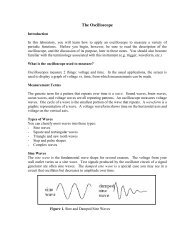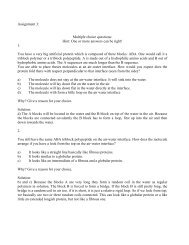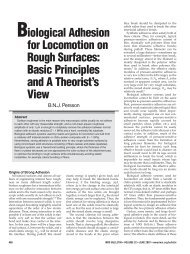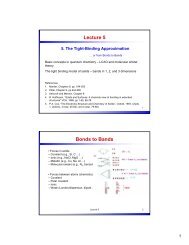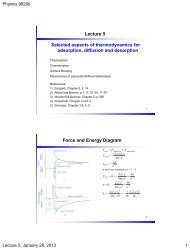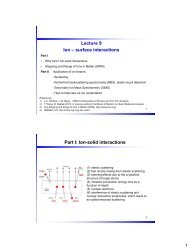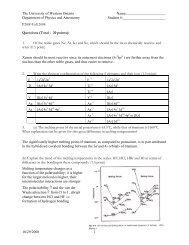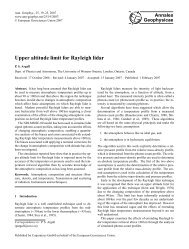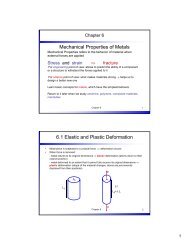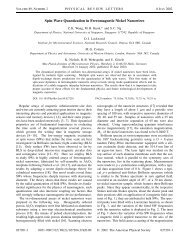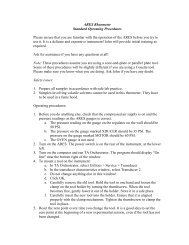Assignment 4 â with Outline Answers
Assignment 4 â with Outline Answers
Assignment 4 â with Outline Answers
Create successful ePaper yourself
Turn your PDF publications into a flip-book with our unique Google optimized e-Paper software.
PHYSICS 208 – 2 nd TERM<br />
Introduction to Materials Science<br />
<strong>Assignment</strong> 4 − <strong>with</strong> <strong>Outline</strong> <strong>Answers</strong><br />
Date of distribution: Tuesday, March 27, 2007<br />
Date for solutions to be handed in: Thursday, April 5, 2007<br />
The questions are all taken from the recommended textbook by Callister (6 th edition).<br />
1. [Question 20.7] 4 marks<br />
(a) We calculate the magnetic susceptibility <strong>with</strong>in a bar of metal alloy when M = 1.2 x 10 6 A/m<br />
and H =200 A/m. Solving for χ m from Eq. (20.6) gives<br />
6<br />
M 1.2 × 10 A/<br />
m<br />
χm<br />
= = = 6000<br />
H 200 A/<br />
m<br />
(b) In order to calculate the permeability we employ Eqs. (20.4) and (20.7) as follows:<br />
µ = µ µ = µ 1+<br />
χ<br />
( )<br />
( )<br />
r o o m<br />
= 1.257 × 10 -6 H/m (6000 + 1) = 7.54 × 10 -3 H/m<br />
(c) The magnetic flux density may then be found from Eq. (20.2) as<br />
-3<br />
B = µ H = 7.54 × 10 H/m (200 A/m) = 1.51 tesla<br />
( )<br />
(d) This metal alloy would exhibit ferromagnetic behavior on the basis of the value of its χ m<br />
(6000), which is considerably larger than typical χ m values for diamagnetic and paramagnetic<br />
materials. Also M is nonzero and large.<br />
2. [Question 20.9] 4 marks<br />
We show that there are 2.2 Bohr magnetons associated <strong>with</strong> each Fe atom. Let n B<br />
'<br />
be the number<br />
of Bohr magnetons per atom, which we will calculate. By definition of magnetization<br />
n B<br />
'<br />
= M s<br />
µ B<br />
N
where N is just the number of atoms per cubic meter. This found from the number of atoms per<br />
unit cell (two for BCC) divided by the unit cell volume, so<br />
2 2<br />
N = =<br />
3<br />
V a<br />
<strong>with</strong> a being the BCC unit cell edge length (i.e., 0.2866 nm). Thus<br />
=<br />
n B<br />
'<br />
C<br />
= M s<br />
µ B<br />
N = M s a3<br />
2µ B<br />
3<br />
6 −9<br />
( 1.70 × 10 / )<br />
⎡( 0.2866 × 10 ) /<br />
⎢⎣<br />
−24 2<br />
(2 atoms / unit cell) ( 9.27 × 10 A- m / BM )<br />
A m m unit cell⎤<br />
⎥⎦<br />
= 2.16 BM/atom<br />
3. [Question 20.10] 4 marks<br />
We want the number of Bohr magnetons per atom of a hypothetical metal that has a SC crystal<br />
structure, an atomic radius of 0.125 nm, and a saturation flux density of 0.85 tesla. From Eqs.<br />
(20.8) and (20.11) it follows that<br />
M s = B s<br />
µ o<br />
= n B µ B<br />
V C<br />
For a SC crystal structure the cell volume V C<br />
= (2r) 3 , where r is the atomic radius. Substituting<br />
this relationship into the above equation and solving for n B<br />
yields<br />
n =<br />
B<br />
3<br />
s ( 8r<br />
)<br />
µ µ<br />
−9<br />
3<br />
(0.85 tesla)(8) ( 0.125 × 10 m)<br />
−6 −24 2<br />
( 1.257 × 10 H / m)( 9.27 × 10 A- m / BM )<br />
B<br />
= = 1.14 Bohr magnetons/atom<br />
o<br />
B<br />
4. [Question 20.25] 5 marks<br />
(a) The saturation flux density for the steel (using the B-H behavior shown in Fig. 20.25) is 1.30<br />
tesla, the maximum B value shown on the plot.<br />
(b) The saturation magnetization is found from Eq. (20.8) as<br />
=<br />
M s = B s<br />
µ o<br />
1.30 tesla<br />
1.257 x 10 −6 H /m = 1.03 x 106 A/m<br />
2
(c) The remanence B r<br />
is read from this plot (Fig. 20.25), giving the value is 0.80 tesla.<br />
(d) The coercivity H c<br />
is read from this plot as 80 A/m.<br />
(e) On the basis of Tables 20.5 and 20.6, this is most likely a soft magnetic material. The<br />
saturation flux density (1.30 tesla) lies <strong>with</strong>in the range of values cited for soft materials.<br />
Although the remanence (0.80 tesla) is close to the values given in Table 20.6 for hard<br />
magnetic materials, the H c is significantly lower than for hard magnetic materials. Finally an<br />
estimate the area of the hysteresis loop gives ~ 250 J/m 3 , which is in line <strong>with</strong> the hysteresis<br />
loss per cycle for soft magnetic materials.<br />
5. [Question 20.28] 3 marks<br />
To demagnetize a magnet having a coercivity of 4000 A/m, an H field of 4000 A/m must be<br />
applied in a direction opposite to that of magnetization. According to Eq. (20.1)<br />
I = H l<br />
N<br />
(4000 A / m) (0.15 m)<br />
= = 6.0 A<br />
100 turns<br />
6. [Question 20.33] 5 marks<br />
We are asked to find which of the SC elements in Table 20.7 are superconducting at 2 K and in a<br />
magnetic field of 40,000 A/m. First of all, in order to be SC at 2 K <strong>with</strong>in any magnetic field, the<br />
critical temperature must be greater than 2 K. Thus, aluminum, titanium, and tungsten cannot be<br />
SC at this temperature.<br />
Then, for each of lead, mercury, and tin, it is necessary, using Eq. (20.12), to find the value of<br />
H c (T). If this value is greater than 40,000 A/m then the element will be SC.<br />
Hence, for Pb<br />
2<br />
B<br />
C(0)<br />
⎡ T ⎤<br />
H<br />
C( T) = ⎢1<br />
−<br />
2 ⎥<br />
µ<br />
0 ⎣ TC<br />
⎦<br />
0.0803 tesla ⎡ (2.0 K)<br />
⎤<br />
= ⎢ − ⎥<br />
1.257 × 10 H / m ⎣ (7.19 K)<br />
⎦<br />
2<br />
4<br />
1 = 5.89 x 10 A/m<br />
−6 2<br />
3
Since this value is greater than 40,000 A/m, lead will be SC.<br />
For Hg<br />
2<br />
0.0411 tesla ⎡ (2.0 K)<br />
⎤<br />
4<br />
H<br />
C( T ) = 1 = 2.51 x 10 A/m<br />
−6 ⎢ −<br />
2 ⎥<br />
1.257 × 10 H / m ⎣ (4.15 K)<br />
⎦<br />
This value is less than 40,000 A/m, so mercury will not be SC.<br />
For Sn<br />
2<br />
0.0305 tesla ⎡ (2.0 K)<br />
⎤<br />
3<br />
H<br />
C( T ) = 1 = 1.73 x 10 A/m<br />
−6 ⎢ −<br />
2 ⎥<br />
1.257 × 10 H / m ⎣ (3.72 K)<br />
⎦<br />
Therefore, tin is not SC.<br />
4



